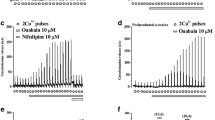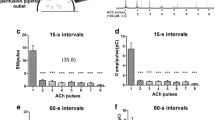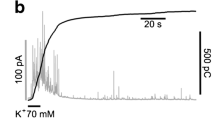Summary
45Ca fluxes and free-cytosolic Ca2+ ([Ca2+] i ) measurements were used to study the effect of Ca2+-mobilizing hormones on plasma membrane Ca2+ permeability and the plasma membrane Ca2+ pump of pancreatic acinar cells. We showed before (Pandol, S.J., et al., 1987.J. Biol. Chem. 262:16963–16968) that hormone stimulation of pancreatic acinar cells activated a plasma membrane Ca2+ entry pathway, which remains activated for as long as the intracellular stores are not loaded with Ca2+. In the present study, we show that activation of this pathway increases the plasma membrane Ca2+ permeability by approximately sevenfold. Despite that, the cells reduce [Ca2+]i back to near resting levels. To compensate for the increased plasma membrane Ca2+ permeability, a plasma membrane Ca2+ efflux mechanism is also activated by the hormones. This mechanism is likely to be the plasma membrane Ca2+ pump. Activation of the plasma membrane Ca2+ pump by the hormones is time dependent and 1.5–2 min of cell stimulation are required for maximal Ca2+ pump activation. From the effect of protein kinase inhibitors on hormone-mediated activation of the pump and the effect of the phorbol ester 12-0-tetradecanoyl phorbol, 13-acetate (TPA) on plasma membrane Ca+ efflux, it is suggested that stimulation of protein kinase C is required for the hormone-dependent activation of the plasma membrane Ca2+ pump.
Similar content being viewed by others
References
Asano, T., Hidaka, H. 1985. Intracellular Ca2+ antagonist, HA 1004: Pharmacological properties different from those of nicardipine.J. Pharmacol. Exp. Ther. 233:454–458
Aub, D.L., McKinney, J.S., Putney, J.W. 1982. Nature of the receptor-regulated calcium pool in the rat parotid gland.J. Physiol. (London) 331:557–565
Brown, G.R., Richardson, A.E., Dormer, R.L. 1987. The role of a (Ca2++Mg2+)-ATPase of the rough endoplasmic reticulum in regulating intracellular Ca2+ during cholinergic stimulation of rat pancreatic acini.Biochim. Biophys. Acta 902:87–92
Bruzzone, R., Halban, P.A., Gjinovci, A., Trimble, E.R. 1985. A new, rapid, method for preparation of dispersed pancreatic acini.Biochem. J. 226:621–624
Bruzzone, R., Pozzan, T., Wollheim, C.B. 1986. Caerulein and carbamylcholine stimulate pancreatic amylase release at resting cytosolic free Ca2+.Biochem. J. 235:139–143
Burnham, D.B., Munowitz, P., Hootman, S.R., Williams, J.A. 1985. Regulation of protein phosphorylation in pancreatic acini. Distinct effects of Ca2+ ionophore A23187 and 12-O-tetradecanoylphorbol 13-acetate.Biochem. J. 235:125–131
Carafoli, E. 1987. Intracellular calcium homeostasis.Annu. Rev. Biochem. 56:395–433
Caroni, P., Carafoli, E. 1981. Regulation of Ca2+ pumping ATPase of heart sarcolemma by a phosphorylation-dephosphorylation process.J. Biol. Chem. 256:9371–9373
Dixon, J., Hokin, L. E. 1984. Sectretagogue-stimulated phosphatidylinositol breakdown in the exocrine pancreas liberates arachidonic acid, stearic acid, and glycerol by sequential actions of phospholipase C and diglyceride lipase.J. Biol. Chem. 259:14418–14425
Dormer, R.L., Poulsen, J.H., Licko, W., Williams, J.A. 1981. Calcium fluxes in isolated pancreatic acini: Effects of secretagoguesAm. J. Physiol. 240:G38-G43
Drummond, A.H. 1985. Bidirectional control of cytosolic free calcium by thyrotropin-releasing hormone in pituitary cells.Nature (London) 315:752–755
Fain, J.N., Berridge, M.J. 1979. Relationship between hormonal activation of phosphatidylinositol hydrolysis, fluid secretion and calcium flux in the blowfly salivary gland.Biochem. J. 178:45–58
Gardner, J.D., Conlon, D.T.P., Klaereman, H.L., Adams, T.D., Ondetti, M.A. 1975. Action of cholecystokinin and cholinergic agents on calcium transport in isolated pancreatic acinar cells.J. Clin. Invest. 56:366–375
Grynkiewicz, G., Poenie, M., Tsien, R.Y. 1985. A new generation of Ca2+ indicators with greatly improved fluorescence properties.J. Biol. Chem. 260:3440–3450
Hidaka, H., Inagaki, M., Kawamoto, S., Sasaki, Y. 1984. Isoquinolinesulfonamides, novel and potent inhibitors of cyclic nucleotide dependent protein kinase and protein kinase C.Biochemistry 23:5036–5041
Hootman, S.R., Williams, J.A. 1987. Stimulus-secretion coupling in the pancreatic acinus.In: Physiology of the Gastrointestinal Tract. L.R. Johnson, editor. pp. 1129–1146. Raven, New York
Kai, H., Kanaide, H., Matsumoto, T., Nakamura, M. 1987. 8-Bromoguanosine 3′:5′-cyclic monophosphate decreases intracellular free calcium concentrations in cultured vascular smooth muscle cells from rat aorta.FEBS Lett. 221:284–288
Kondo, S., Schulz, I. 1976. Calcium ion uptake in isolated pancreas cells induced by secretagogues.Biochim. Biophys. Acta 419:76–92
Kondo, S., Schulz, I. 1976. Ca++ fluxes in isolated cells of rat pancreas: Effect of secretagogues and different Ca++ concentrations.J. Membrane Biol. 29:185–203
Korchak, H.M., Rutherford, L.E., Weissmann, G. 1984. Stimulus response coupling in the human neutrophil. I. Kinetic analysis of changes in calcium permeability.J. Biol. Chem. 259:4070–4075
Lagast, H., Pozzan, T., Waldragel, F.A., Lew, D.P. 1984. Phorbol myristate acetate stimulates ATP-dependent calcium transport by the plasma membrane of neutrophils.J. Clin. Invest. 73:873–883
Matthew, E.K., Peterson, O.H., Williams, J.A. 1973. Pancreatic acinar cells: Acetylcholine-induced membrane depolarization, calcium efflux and amylase release.J. Physiol. (London) 234:689–701
Mauger, J.P., Poggioli, J., Guesdon, F., Claret, M. 1984. Noradrenaline, vasopressin and angiotensin increase Ca2+ influx by opening a common pool of Ca2+ channels in isolated rat liver cells.Biochem. J. 221:121–127
Merritt, J.E., Rink, T.J. 1987 Regulation of cytosolic free calcium in Fura-2 loaded rat parotid acinar cells.J. Biol. Chem. 262:17362–17369
Merritt, J.E., Rubin, R.P. 1985. Pancreatic amylase secretion and cytoplasmic free calcium: Effect of ionomycin, phorbol dibutyrate and diacylglycerols alone and in combination.Biochem. J. 230:151–159
Muallem, S., Beeker, T., Pandol, S.J. 1988. Role of Na+/Ca2+ exchange and the plasma membrane Ca2+ pump in hormone-mediated Ca2+ efflux from pancreatic acini.J. Membrane Biol. 102:153–162
Muallem, S., Fimmel, C.J., Pandol, S.J., Sachs, G. 1986. Regulation of free cytosolic Ca2+ and secretion in parietal and peptic cells.J. Biol. Chem. 261:2660–2667
Muallem, S., Schoeffield, M.S., Fimmel, C.J., Pandol, S.J. 1988. The agonist-sensitive calcium pool in the pancreatic acinar cell: I. Permeability properties.Am. J. Physiol. 255:G221-G228
Muallem, S., Schoeffield, M.S., Fimmel, C.J., Pandol, S.J. 1988. The agonist-sensitive calcium pool in the pancreatic acinar cell: II. Characterization of reloading.Am. J. Physiol. 255:G229-G235
Neyses, L., Reinlib, L., Carfoli, E. 1985. Phosphorylation of the Ca2+ pumping ATPase of heart sarcolemma and erythrocyte plasma membrane by the cAMP-dependent protein kinase.J. Biol. Chem. 260:10283–10287
Nishizuka, Y. 1986. Studies and perspectives of protein kinase C.Science 233:305–312
Noguchi, M., Adachi, H., Gardner, J.D., Jensen, R.T. 1985. Calcium-activated, phospholipid-dependent protein kinase in pancreatic acinar cells.Am. J. Physiol. 248:G692-G701
Ochs, D.L., Korenbrot, J.I., Williams, J.A. 1985. Relationship between agonist-induced changes in the concentration of free intracellular calcium and the secretion of amylase by pancreatic ancini.Am. J. Physiol. 249:G389-G398
Pandol, S.J., Schoeffield, M.S. 1986. 1,2-Diacylglycerol, protein kinase C, and pancreatic enzyme secretion.J. Biol. Chem. 261:4438–4444
Pandol, S.J., Schoeffield, M.S., Fimmel, J.C., Muallem, S. 1987. The agonist-sensitive calcium pool in the pancreatic acinar cell: Activation of plasma membrane Ca2+ influx mechanism.J. Biol. Chem. 262:16963–16968
Pandol, S.J., Schoeffield, M.S., Sachs, G., Muallem, S. 1985. The role of free cytosolic calcium in secretagogues stimulated amylase release from dispersed acini from guinea pig pancreas.J. Biol. Chem. 260:10081–10086
Pandol, S.J., Thomas, M.W., Schoeffield, M.S., Sach, G., Muallem, S. 1985. Role of Ca2+ in cholecystokinin-stimulated phosphoinositide breakdown in exocrine pancreas.Am. J. Physiol. 248:G551-G560
Poggioli, J., Putney, J.W. 1982. Net calcium fluxes in rat parotid acinar cells: Evidence for a hormone-sensitive calcium pool in or near the plasma membrane.Pfluegers Arch. 392:239–243
Pollock, W.K., Sage, S.O., Rink, T.J. 1987. Stimulation of Ca2+ efflux from Fura-2-loaded platelets activated by thrombin or phorbol myristate acetate.FEBS Lett. 210:132–136
Pozzan, T., Lew, D., Wollheim, C.B., Tsien, R.Y. 1983. Is cytosolic ionized calcium regulating neutrophil activation?Science 221:1413–1415
Putney, J.W. 1986. A model for receptor-regulated calcium entry.Cell Calcium 7:1–12
Putney, J.W. 1987. Formation and actions of calcium-mobilizing messenger, inositol 1,4,5-trisphosphate.Am. J. Physiol. 252:G149-G157
Reinhart, P.H., Taylor, W.M., Bygrave, F.L. 1984. The action of alpha-adrenergic agonists on plasma membrane calcium fluxes in perfused rat liver.Biochem. J. 220:43–50
Reinhart, P.H., Taylor, W.M., Bygrave, F.L. 1984. The role of calcium ions in action of alpha-adrenergic agonists, in rat liver.Biochem. J. 223:1–13
Richard, J.E., Sheterline, P. 1985. Evidence that phorbol ester interferes with stimulated Ca2+ redistribution by activating Ca2+ efflux in neutrophil leucocytes.Biochem. J. 231:623–628
Richardson, A.E., Dormer, R.L. 1984. Calcium-ion-transporting activity in two microsomal subfractions from rat pancreatic acini: Modulation by carbamylcholine.Biochem. J. 219:679–685
Rink, T.J., Sage, S.O. 1987. Stimulated calcium efflux from Fura-2-loaded human platelets.J. Physiol. (London) 393:513–524
Sadler, K., Litosch, I., Fain, J.N. 1984. Phosphoinositide synthesis and Ca2+ gating in blowfly salivary glands exposed to 5-hydroxytryptamine.Biochem. J. 222:327–334
Schofield, J.G. 1983. Use of a trapped fluorescent indicator to demonstrate effects of throliberin and dopamin on cytoplasmic Ca2+ concentration in bovine anterior pituitary cells.FEBS Lett. 159:79–82
Schulz, I. 1980. Messenger role of calcium in function of pancreatic acinar cells.Am. J. Physiol. 239:G335-G347
Sha'afi, R.I., Moalski, T.F.P., Huang, C.K., Naccache, P.H. 1986. The inhibition of neutrophil responsiveness caused by phorbol esters is blocked by the protein kinase C inhibitor H7.Biochem. Biophys. Res. Commun. 137:50–60
Smallwood, J.I., Gugi, B., Rasmussen, H. 1988. Regulation of erythrocyte Ca2+ pump activity by protein kinase C.J. Biol. Chem. 263:2195–2202
Streb, H., Bayerdörffer, E., Haase, W., Irvine, R.F., Schulz, I. 1984. Effect of inostiol-1,4,5-trisphosphate on isolated subcellular fractions of rat pancreas.J Membrane Biol. 81:241–253
Streb, H., Heslop, J.P., Irvine, R.F., Schulz, I., Berridge, M.J. 1985. Relationship between secretagogue-induced Ca2+ release and inositol polyphosphate production in permeabilized pancreatic acinar cells.J. Biol. Chem. 260:7309–7315
Streb, H., Irvine, R.F., Berridge, M.J., Schulz, I. 1983. Release of Ca2+ from a nonmitochondrial intracellular store in pancreatic acinar cells by inositol-1,4,5-trisphosphate.Nature (London) 306:67–69
Williamson, J.R., Cooper, R.H., Joseph, S.K., Thomas, A.P. 1985. Inositol trisphosphate and diacylglycerol as intracellular second messengers in liver.Am. J. Physiol. 248:C203-C216
Wright, C.D., Hoffman, M.D. 1986. The protein kinase C inhibitors H7 and H9 fail to inhibit human neutrophil activation.Biochem. Biophys. Res. Commun. 135:749–755
Author information
Authors and Affiliations
Rights and permissions
About this article
Cite this article
Muallem, S., Pandol, S.J. & Beeker, T.G. Calcium mobilizing hormones activate the plasma membrane Ca2+ pump of pancreatic acinar cells. J. Membrain Biol. 106, 57–69 (1988). https://doi.org/10.1007/BF01871767
Received:
Revised:
Issue Date:
DOI: https://doi.org/10.1007/BF01871767




